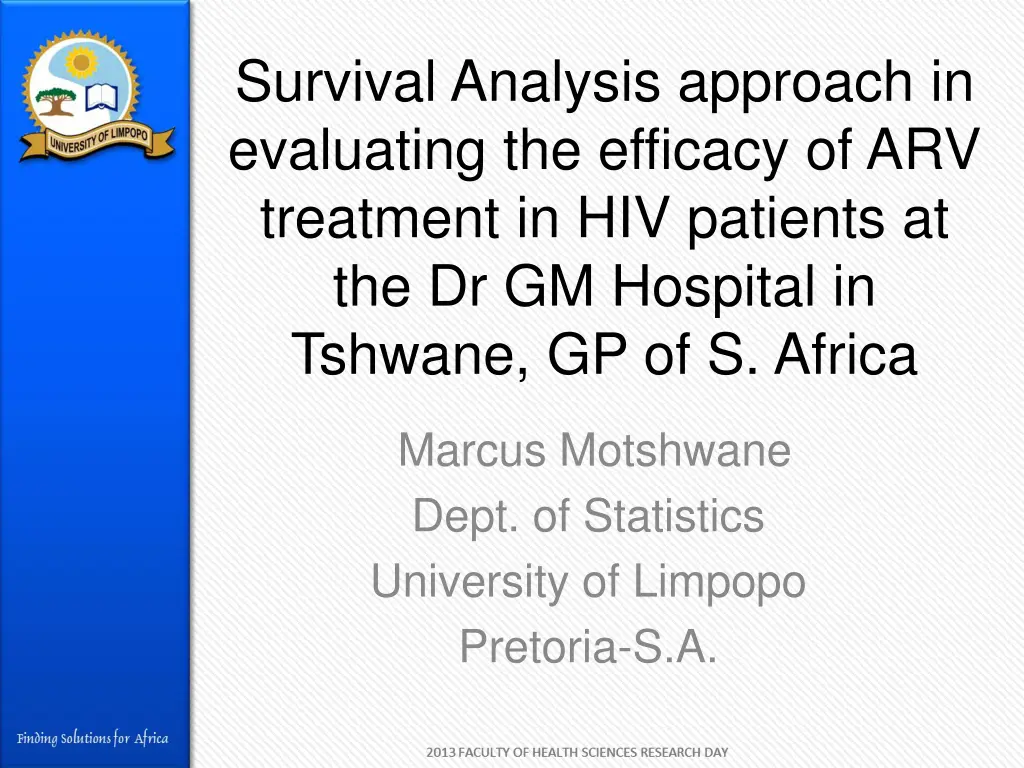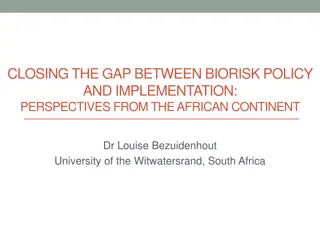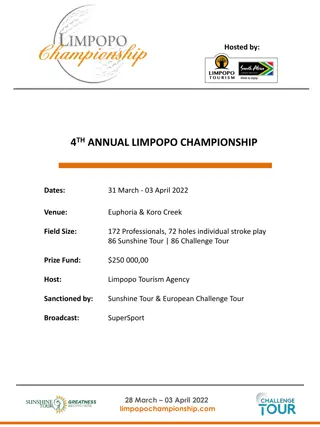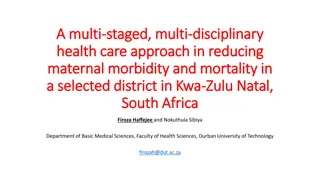
Analyzing Efficacy of ARV Treatment in HIV Patients Using Survival Analysis Approach in Dr. GM Hospital
Explore the efficacy of antiretroviral (ARV) treatment in HIV patients at Dr. GM Hospital in Tshwane, South Africa, through survival analysis. The study aims to model ARV treatment efficacy and its association with patient survival, analyzing data from 2007-2011 among 318 HIV/AIDS cases. Various factors such as days on ARV, age, residential area, CD4 count, and viral load are considered in evaluating patient outcomes.
Download Presentation

Please find below an Image/Link to download the presentation.
The content on the website is provided AS IS for your information and personal use only. It may not be sold, licensed, or shared on other websites without obtaining consent from the author. If you encounter any issues during the download, it is possible that the publisher has removed the file from their server.
You are allowed to download the files provided on this website for personal or commercial use, subject to the condition that they are used lawfully. All files are the property of their respective owners.
The content on the website is provided AS IS for your information and personal use only. It may not be sold, licensed, or shared on other websites without obtaining consent from the author.
E N D
Presentation Transcript
Survival Analysis approach in evaluating the efficacy of ARV treatment in HIV patients at the Dr GM Hospital in Tshwane, GP of S. Africa Marcus Motshwane Dept. of Statistics University of Limpopo Pretoria-S.A.
Background Survival analysis is aimed at estimating the probability of survival, relapse or death that occurs over time Relevant in clinical studies evaluating the efficacy of treatments in humans or animals Commonly deals with rates of mortality and morbidity
Problem statement The efficacy of ARV treatment at Dr G Mukhari hospital is favourable, but not clear as to the extend they are helpful to patients Survival analysis, a scientific statistical tool is conducted to- -model ARV treatment efficacy in HIV patients -confirm the association between survival or not of patients after ARV treatment
Data Analysis 2007-2011 raw data 318 HIV/AIDS cases 24 variables selected STATA (12), SAS (9.2) & SPSS(21)
Year 30 27.67 25 20.44 20.13 20 16.04 15.72 15 10 5 0 2OO7 2OO8 2OO9 2O1O 2O11
No. of days on ARV 18 16.7 16 14 11.9 11.6 12 11 10.7 10.4 10 9.1 8.2 8 6 4.1 3.8 4 2.5 2 0
Age (Years) 40 36.8 35 30.8 30 25 20 18.6 15 10 8.2 5.3 5 0.3 0 15-25 26-35 36-45 46-55 56-65 66-75
Residential Area 40 37.11 35 30 25 20 18.55 15 10.69 9.12 10 5.03 4.4 3.77 5 3.46 3.46 2.83 1.57 0
CD4 Count 50 45 43.4 40 34.6 35 30 25 20 15 13.2 10 5 5 2.5 0.9 0.3 0 0-100 101-200 201-300 301-400 401-500 501-600 601-700
Viral Load 80 68.9 70 60 50 40 30 17.6 20 13.5 10 0 <1000 1001-50000 >50000
Survival function Used to describe the time-to-event concept for all patients. This is the probability of an individual to survive beyond time x and is defined as : Is a non-increasing function with a value of 1 at the origin and 0 at infinity. This is the case here with 1 at four days (4) and zero at the end of (1781) days, meaning that there is conformity with the survival function.
Kaplan-Meier Estimate Kaplan-Meier survival estimate 1.00 0.75 0.50 0.25 0.00 0 500 1000 1500 2000 analysis time
Kaplan-Meier estimate (cont) It is an estimator of the survival function- also called the product limit estimator It is a function of the probability of survival plotted against time In the ith interval, the probability of death can be estimated by:
Kaplan-Meier (cont) The estimated survival probability is: = Where, - d = number of deaths observed at time t - n =the number of patients at risk
Kaplan-Meier (cont) All patients were alive at time t=o They remained so until the first patient died after four (4) days. The estimate of the probability of surviving at zero is 1.0 The estimate of the survival function is thus: at t=o
The log-rank test Log-rank test for equality of survivor functions | Events Events group | observed expected ------+------------------------- 0 | 0 20.09 1 | 26 5.91 ------+------------------------- Total | 26 26.00 chi2(1) = 105.26 Pr>chi2 = 0.0000
The log-rank test (cont) The observed values are different from the expected values Produce a highly significant chi- squared value (P < 0.05). The null hypothesis is rejected at the 5% level of significance Survivor functions of the two groups are not the same.
Hazard function Cox proportional hazards regression .002 .0015 Smoothed hazard function .001 .0005 0 0 500 1000 1500 analysis time
Hazard function It is the proportion of subjects dying or failing in an interval per unit of time As days pass, the number of patients dying also increases It is an increasing function as opposed to the non-increasing function of the Kaplan-Meier survival estimate.
Cox survival curve Cox proportional hazards regression 1 .8 .6 Survival .4 .2 0 0 500 1000 1500 2000 analysis time
Cox survival curve The graph of the estimated baseline survivor function The Cox approach is the most widely used regression model in survival analysis The probability of survival is 1 at time t=0 Drops to 0 as the number of days elapses to maximum of 1781.
Cox regression model No. of subjects = 312 Number of obs = 312 No. of failures = 26 Time at risk = 249675 LR chi2(7) = 13.54 Log likelihood = -96.694567 Prob > chi2 = 0.0599 ------------------------------------------------------------------------------ _t | Haz. Ratio Std. Err. z P>|z| [95% Conf. Interval] -------------+---------------------------------------------------------------- gender2 | .6791803 .2879292 -0.91 0.361 .2958897 1.558979 age | 1.032749 .0259595 1.28 0.200 .9831025 1.084903 marital2 | .3615232 .1486429 -2.47 0.013 .1614947 .8093083 education2 | 1.084283 .0966501 0.91 0.364 .9104767 1.291268 township2 | .8435348 .0977518 -1.47 0.142 .6721447 1.058628 cd4 | .9987908 .0023613 -0.51 0.609 .9941735 1.00343 viral | 1 5.54e-08 -0.20 0.845 .9999999 1 ------------------------------------------------------------------------------
Cox reg.model (cont) It asserts that the hazard rate for the ith subject in the data is The model is thus:
Cox reg.model (cont) Since P> 0.05 for gender, age, education, township, cd4 count and viral load, No significant statistical difference amongst these variables with regard to the predictor variable, days ARV.
Conclusion 92%(292/318) were alive after ARV treatment as compared to 8%(26/318) that died At the 5% level of significance, significant hazard ratios were characterised by hazard ratios that are significantly different from 1 , and 95% confidence interval (CI) ARV had a significant statistical impact on AIDS patients survival Overall mortality rates have decreased
FINALLY THANK YOU






















